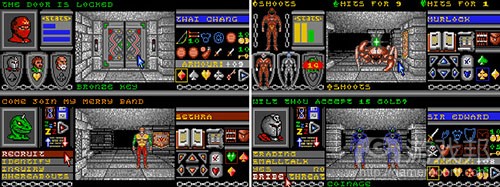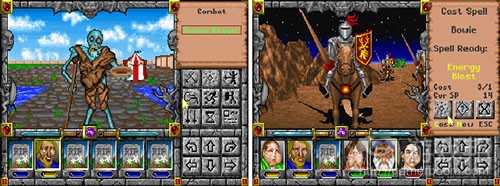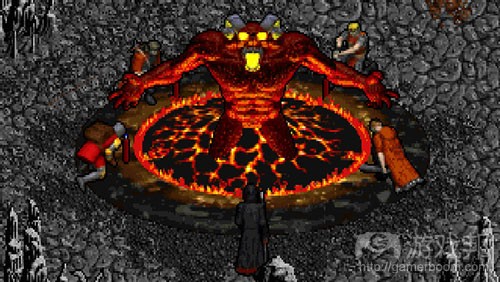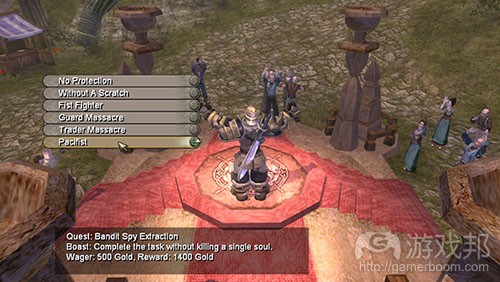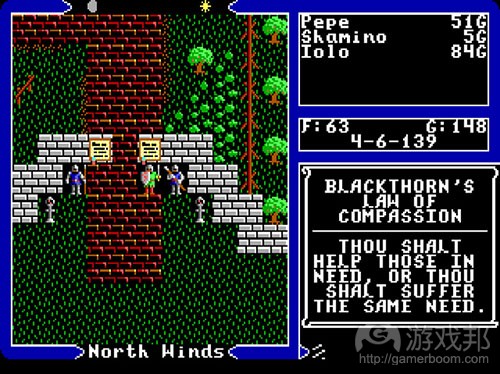CRPG历史之21款带有创造性内容的PRG游戏
作者:Felipe Pepe
你们中的有些人可能会知道,我是一个致力于推广计算机RPG及其漫长历史的非营利性但却充满资源的CRPG Book Project的编辑。
在过去18个月里我一直致力于审查将近300款RPG,既包括最新发行的游戏也包括70年代的柏拉图式游戏。而所有的这些研究都将被收录到一本书中,不过我最终意识到并非所有人都认为一本关于RPG的400多页的书籍有多酷,所以我最终决定对其进行删减并只侧重一些真正有趣的内容。
以下便是我所认为的最有趣的一些内容。虽然我所提到的大多是一些较不出名的游戏,但同时我也会添加一些不可错过的知名游戏:
《Dungeons of Daggorath》(1982年)
因为出现在《Ready Player One》,最近这款游戏又重新得到了关注,但其实它值得拥有更高的知名度。据报道这是一款诞生于1980年的游戏,并且它是带有快节奏的实时战斗的地牢爬行游戏。如果说作为一部先驱作品,它的确带有一些很有趣的内容。
每个行动都必须被输入文本分析程序中,可以是完整的句子也可以使用缩略语。但因为游戏是实时运行的,因此如果你能够更快速地输入内容,你便能够更快速地行动。作为补偿,游戏中并没有随机的失败设置,每次的疏漏都只是因为玩家的输入错误。这也是处理失误的一种有机方式。
游戏的突出功能是其心率机制。在超过40多年的CRPG历史中,只有少数机制和概念是根植于核心类型中。而生命值便是其中之一。但因为《Dungeons》是一款早前游戏,所以当时的设计师尝试了一些不同的内容。
你的生命状况是由屏幕中央跳动的心所决定的,同时还带有心跳的声音。正常的心率意味着你是健康的,但随着你受伤,奔跑或快速发动攻击,你的心率跟着便会上升。如果你的心遭到攻击,你便会死亡。幸运的是如果你成功找到一个安全的地方并获得 喘息的机会,你的心率便有可能恢复正常。
玩家通常都是带着耳机在玩这款游戏。你会因为不断奔跑并进入一个死胡同而心快加速并感到神经奔溃。
《Alternate Reality: The City》(1985年)
Philip Price是致力于B-2 Stealth Bomber的一名程序员。但是在此之前他曾经为雅达利8位体计算机创造过游戏,而《Alternate Reality》便是他的代表作(未完成)。
这是一个充满野心的项目,Price希望它是作为一个带有7个场景的系列游戏。第一款游戏《The City》是从一艘巨大的宇宙飞船把你从地球带到一个幻想城市而开始。在那里你必须装备自己,访问这座城市的公会,并与盗贼和疯狂的巫师进行战斗。一旦你觉得自己准备好了,你便可以将角色带到第二款游戏《The Dungeon》中,并继续你的冒险,即找寻回家的方法。
不幸的是他最终只发行了两款游戏,所以他并未能实现这一伟大的目标。
尽管如此《Alternate Reality》也拥有一个让人印象深刻的功能:它完全利用了雅达利8位体功能去传达一个电影般的描述,并突出了来自Gary Gilbertson让人难以忘怀的歌曲。我只想说这款诞生于1985年的游戏是从一个5分钟的开场过场动画而开始,并伴随着主题歌与附带的歌词。这款游戏中还出现了许多其它歌曲,包括玩家死去时出现的歌曲以及有关怀念失去的爱人的浪漫情歌。
已经过去了30年,但是我却未曾看过一款游戏能够使用这样的方法在游戏中使用歌曲。
更重要的是,单纯的文字已不足以表达我对于在YouTube或OverClocked ReMix上找不到任何游戏歌曲的混音的失望。
《Alien Fires: 2199 A.D.》(1986年)
这款游戏的诞生是源自技术局限性所引起的好奇心,虽然我不能说它是成功的,但我却想为它的独创性鼓掌。
事情是这样的:你真心想要在你的RPG中添加有声的对话,但因为你生活在1986年,那时候的游戏还是被装在两个5又1/4英寸的磁盘中进行出售,每个磁盘只有720千字节大。那你该怎么做?你只要将语音软件整合到磁盘中便可。
或许这么做不可行,但这毕竟是一次有趣的尝试。
《Wizardry IV: The Return of Werdna》(1987年)
在《Wizardry I》中你将深入研究疯狂的霸王的试验场,探索一个拥有10个级别的地下城并打败邪恶的巫师Werdna去拯救世界。
而在《Wizardry IV》中,邪恶的巫师Werdna将再次回归。这部游戏中的一个有趣转折是,你将扮演Werdna的角色。因为战败而被削弱了能力的你将召唤怪兽作为你那方的成员并且它将带着你完成10个级别的地下城任务去寻求复仇方式。
另一个吸引人的转折是,这次你将面对的不再是怪兽,而是英雄。更准确地说,玩家所创造的冒险群组将通过电子邮件向开发者发送他们所拯救的游戏。这同时也是最复杂的RPG之一—-游戏中的战斗非常困难,玩家很难在地下城中行进,并且还有一个无敌的幽灵不断追着玩家想要杀死他并复活所有敌人。说实话,想要征服这个世界绝不是件容易的事。
《Bloodwych》(1989年)
《Dungeon Master》是1986年的一次改革,因为它将实时战斗,精心设计的谜题与可怕的地下城结合在一起,并且它的贡献仍然延续到了今天的游戏上,如《魔岩山传说》。
而《Bloodwych》也使用了《Dungeon Master》的方法并将其调整到11。首先,这款游戏拥有多人游戏机制—-两名玩家能够一起坐在计算机前,一名玩家控制鼠标而另一名玩家控制操纵杆,他们将沉浸于多画面的合作中。
此外,玩家还能尝试着与敌人交谈,询问信息,有时候也能贿赂对方放自己通行。之后进一步扩展的游戏《The Extended Levels》甚至还允许敌人能够受聘于玩家—–前提是玩家能够说服他们这么做。
同时当玩家获得升级时,小精灵便会出现在你的梦里并卖给你全新咒语。
《World of Ultima: The Savage Empire》(1990年)和《Martian Dreams》(1991年)
来自Origin的成员使用了《Ultima VI》的引擎,50年代的杂志以及各种想象力并将其结合成两款衍生的Ultima游戏。
在第一款游戏《The Savage Empire》中,游戏角色将被带到一个游走着恐龙的山谷中,而他必须与原始人结盟去对抗一群昆虫般的生物。
《The Savage Empire》同样也是第一款你能够虚构一个角色并在Kurak Tribe的公主Aiela以及她的妹妹(被领养的)Tristia之间做出选择的RPG游戏。
而在《Martian Dreams》中你将穿越回到维多利亚时期并加入一支前往火星的探险队,同行成员包括Nicolas Tesla,Sigmund Freud和Warren Spector。同时游戏中还有机器人,火星人,梦境机,精心设计的反转情节,H.G.Wells,Buffalo Bill,Calamity Jane和Rasputin。
没错,这款游戏早于Alan Moore的《超凡绅士联盟》10年便诞生了。
《Ishar: Legend of the Fortress》(1991年)
现在,NPC已经成为RPG设计中的一个定律,但是回到1991年,那时候的群组成员只是一些会制造伤害并一直行走着的游戏元素。来自法国的开发者Simarilis尝试着通过赋予游戏中每个群组成员个性与看法而解决这一问题,而这也是最具民主性的RPG。
假设你沿着一条街往下走并且你不喜欢一个猥亵的人一直看着自己。于是你便命令你那凶猛的冒险群组成员去攻击那个人,但是这些群组成员会踌躇一下并投票做出决定。较邪恶的角色表示赞同,而和善的角色可能会拒绝,还有一些人持中立态度,但是投票的最终结果是明确的,即玩家只能顺从民意。
这种设定也适用于将一个角色从群组中开除或聘请一个新角色等决定。你需要谨慎地组织你的群组,就像一个英雄群组可能不会允许你聘请一个疯狂的野蛮人,而邪恶的骑士群组可能也不会理解拥有治愈咒语的可爱精灵的价值。
有些角色可能会欺骗你—-你在这款游戏中找到的第一个群组成员将会掠夺你的东西并在你闭上眼睛的时候瞬间消失。
《Might & Magic: World of Xeen》(1992年)
还记得1994年发行的《Sonic & Knucles》吗?你甚至可以将《Sonic 2》或《Sonic 3》的磁带置于第一部游戏上方并同时玩这两款游戏,这时候你将拥有Knuckles以及其它全新内容。
很酷的是,一个名为Jon Van Caneghem的人不仅在更早前便想到了这一理念,同时他更是将其应用于一款RPG上。1992年,他发行了《Might & Magic IV: Clouds of Xeen》,紧接着在1993年又推出了《Might & Magic V: Darkside of Xeen》。在这些游戏中你都将探索一个货币形状的星球Xeen的一边。
然而如果你同时安装了这两款游戏,游戏便会整合在一起变成“World of Xeen”,即让你能够按照自己的节奏在星球的两边自由行走并探索,同时游戏中还会添加一个全新的游戏任务,在那里你将面对布满Xeen星球两边的高级别挑战,并且你将在此揭开游戏的真正结局。
同样值得一提的是游戏中还有一条横跨Xeen的天路,即你可以使用Levitate咒语走过去。
《Wizardry VII – Crusaders of the Dark Savant》(1992年)
关于《Wizardry VII》有很多可以讨论的,但我将在此专注于NPC。
在大多数RPG中,不管它们的AI多么出色,玩家总是会觉得自己是游戏中唯一一个在做着某事的人。而世界上最畅销的一款RPG《神奇宝贝》则是例外,在这款游戏中玩家会知道至少有一名对手也在做着某事。
而《Wizardry VII》的情节则是围绕着Lost Guardia世界神秘的McGuffin的研究而展开。各个群组都在搜索着这一目标,包括阴险的Dark Savant,而游戏玩法也以一种非常新颖的游戏内部方式去呈现这一疯狂的搜索。
《Wizardry VII》突出了多个在游戏世界中行走的NPC群组,有的在掠夺道具,有的则在执行任务。在一个攻略中玩家将会在一个金库中找到一张地图碎片,但是在另一个攻略中玩家有可能只能找到一个空的金库,因为已经有人捷足先登了。
然后玩家将追踪其他群组,参与对话并尝试着获得地图碎片。如果对方拒绝给予你地图碎片,你便可以杀了他。但这里始终存在一种结果,即NPC集团在一看到你的时候便会对你发动攻击。
这是一个非常出色的系统,能够生动地呈现出游戏世界,让每一个攻略都是不同的。而更让人印象深刻的是,这其实是由一个人所设计并编程的游戏。
《Ultima VIII: Pagan》(1994年)
很多《Ultima》粉丝都很讨厌这款游戏,而这一切也都是有原因的。因为它删掉了许多《Ultima VII》的功能,并添加了让人讨厌的platforming部分。
然而它也拥有一个很出色的设定。Guardian,也就是游戏角色的大敌将你驱逐到蛮荒的Pagan世界。被带到那里的你必须想办法找到回家的路。这不是件简单的事,因为Pagan是一片黑暗且可怕的区域,那里的人都将Guardian奉为上帝。
Guardian总是不断讥讽角色在Britannia所创造的破坏,而玩家也会不断沉浸于更让人不安的行动中,如欺骗,背叛,杀戮,甚至是向恶魔屈服等他们在《Ultima IV》中所了解到的所有反英雄行为。
《Pagan》可能是最黑暗的一款游戏。玩过之前游戏的《Ultima》粉丝始终都拥护着这系列游戏所具有的优点,但是《Pagan》却让他们感到非常绝望。虽然这款游戏提供给玩家完整的控制权,但是它也问了玩家一个问题:为了达到结局是否能够不择手段?
《Wizardry 8》(2001年)
最后一款《Wizardry》游戏是由西方国家完成的,而它也带来了两个有趣且新颖的功能。
首先,它重新塑造了该系列中我们所熟知的“blobber”游戏玩法。比起作为一个blob在一个个方形中不断行进,玩家将能够自由穿越3D环境。在玩家前面设置一个重装甲战士并在后面设置一个投手已经不再是什么默认信息了,因为敌人将围绕在玩家身旁,前面的战士将不能触及后面的敌人。这也为游戏添加了一个全新的战术深度层面。
第二个功能便是纯粹的天赋,但这也是这款游戏最让人印象深刻的功能之一。许多RPG都让玩家能够创造角色并为角色选择一个声音,但是《Wizardry 8》提供给了玩家九种不同的性格(游戏邦注:包括孤独,率直,混乱,松散,古怪,聪明,善良,好斗与狡猾),且每种性格都有面向不同性别的两种不同声音选择,也就是总共有36种基于声音的性格。
不只有声音会基于不同方式说出“是的”,“我扛不住了”,“攻击”以及“我受伤了”等内容,这些性格也会直率地表达出它们的看法,并对各种事件,环境,敌人和任务作出反应,即创造出比其它RPG中预先设定好的NPC更有魅力且更让人印象深刻的角色。
你还可以选择一条超能力龙,并操着一口浓厚的德国口音絮叨着这个世界的混沌本性。或者你也可以选择一只武士猫以第三人称的诗歌形式去描述你的冒险。再或者你也可以同时做出两种选择!
《Geneforge》(2001年)
说到创造群组成员,《Geneforge》将这一概念带到了一个全新层次。
Jeff Vogel的杰作引进了一个全新的设置,即将幻想与技术相结合,并且没有人和衍生内容。在这个世界中有名为Shapers的巫师,他们能够创造并操控生活。他们利用这一能力能够创造仆人为自己工作,同时他们还会尝试一些新技术并不断壮大自己的势力。
在游戏中玩家将作为一个被困于一个神秘孤岛的Shaper,同时他也可以创造生物帮助自己赢得战斗。
这里具有很棒的游戏深度:玩家可以独自定制每个生物,并在一个强大的怪物身上耗尽自己的能量,同时还能够创造一些较弱的生物,或者他们也可以完全忽视这一功能而去使用能量投射咒语。
《ZanZarah: The Hidden Portal》(2002年)
记得在90年代末期,一边饲养着“神奇宝贝”并玩着《Quake》的死亡竞赛然后一边进行兔子跳还是一件非常疯狂的事。而你是否想过将这些事都整合在一起有多酷吗?
来自德国的一些人便进行了尝试,并创造出了《ZanZarah》这款游戏—-在这里玩家将作为一个年轻的英国女士去探索一个神奇的世界,并为了参与一个快速的第一人称竞赛而去收集精灵,恶魔,龙等等神奇的生物。
游戏中的许多竞技场都带有一些有趣的布局,各种可供选择的技能,具有有效和无效关系的各种生物类型以及玩家能够用于捕捉野生生物的魔法球。当然了,当玩家的生物到达一定级别时也会开始进化。
也许有人会好奇为什么之后没人继续使用这一概念,但其实我们很容易看到可爱的精灵与竞技场上的杀戮的结合并不符合市场营销的需求。
《神鬼寓言》(2004年)
没错,《神鬼寓言》并非一款无名的游戏,而我之所以在这里提到这款游戏是因为这款游戏有着一个鲜少被人提及的有趣的机制。
我非常喜欢自我挑战。例如独自玩带有疯狂的多种类别的角色的《博德之门2》或者不使用自己已经精通的盾牌在玩《暗黑之魂》,并强迫自己适应并尝试一些永远都不会做的事。
而《神鬼寓言》拥有一个“自夸”机制,即基于一种非常有趣的游戏形式去执行自我挑战。在游戏中玩家将扮演想要获得名气的英雄,如此为什么不以大多数英雄事例那样呈现在人们面前呢?执行杀死白色狼人的任务算是一大壮举了,但是《神鬼寓言》让玩家能够出现在雀跃的观众面前炫耀自己能够毫发无伤地徒手杀死狼人。
对于每次自夸你都需要押上金子,如果失败的话你便会付出代价,但成功的话也能够获得不错的奖励。遗憾的是这一功能并未出现在之后的续集中。
《Magical Diary》(2011年)
这是一款关于一个女生发现自己是巫师Harry并前往魔法学院上学,在那里参加学校活动,交朋友,上课,学习咒语并找到能够一起参加毕业舞会的男生的视觉小说和RPG的混合游戏。
现在,如果你还在阅读本篇文章的话,你便会知道为什么你应该将偏见置于一旁:《Magical Diary》拥有最灵活且最有趣的地下城/谜题系统。
有时候你需要参加测试,即瞬间移动到迷宫并努力走出迷宫。这些挑战包括捕捉怪兽,对抗另一位巫师,或穿越峡谷。而所有的解决方法都是取决于你—-即使用游戏中70多种咒语。举个例子来说吧,为了逃离怪兽的追捕,你可以使用各种具有攻击性的咒语去杀死它,或瞬间移动到其它地方,或分散它的注意力,吓跑它,弄瞎它,对它进行催眠,或在迷宫中挖隧道等等。
这是一个非常丰富的系统,能够提供给你施法者应该具有的各种选择,而不是只让你戴上魔法帽并发射火球那么简单。遗憾的是这款游戏非常短,只拥有7个地下城挑战,但这却是我希望能够继续探索的有趣系统。
《远征军:征服者》(2013年)
这是一款基于真正的历史故事的游戏,但它却不是以欧洲,美国或日本为背景。先暂停下,你们先算算除了《三国无双》外你们还能想到多少这样的游戏。
此外,处理真正发生过的文化冲突(如,基于语言障碍,偏见,种猪问题,宗教教条,错误传达和过往的冲突等)会让人觉得更加真实且更具接地气。
当你在组建自己的探险队时,你需要雇佣一些追随者,并且他们都拥有自己的个性。例如Blanca Alegría是一个无私且虔诚的修女,会在你慷慨地对待其他殖民者,特别是穷人时赞扬你。但她同时也是个种族主义者,会强烈抵抗你所遇到的所有土著人,并制止你的所有异教仪式(必要的话可能还会采取暴力形式)。
每个角色都有自己的缺陷。避开所有种族主义者将迫使你选择一些骄傲,贪婪,自恋或好胜心很强的人,这里并不存在绝对的善良与邪恶。
《末日拾荒者》(2014年)
不知道从什么时候开始逐条记载便意味着“让我们复制《暗黑破坏神》”,甚至是基于群组的单人玩家RPG也在使用DPS去衡量武器的破坏力,而这款来自前BioWare员工的游戏则选择了完全相反的道路,即勇敢地对现代游戏设计趋势发起了挑战。
在《末日拾荒者》中,你永远都不会知道一个武器有多大的破坏性,一个盔甲能够提供多大的保护作用,或者你和敌人拥有多少生命值。你所知道的只有现在正在下雨,身穿卫衣的你正握着一把刀站在黑暗的森林中与刚刚伤了你的腿并疯狂挥舞着铁锹的异教徒相抗衡着。这是一款rogue般的生存游戏,将挑战你的独自思考能力,或者需要你能从失败中获得学习。
这是一款你不能因为工具提示是绿色的或者说它拥有+10%的火力而用刀去换棒球棒的游戏,而应该是作为玩家的你觉得拥有这样的工具更加安全。就像你认为骨头断裂也比流血好一点。基于假设你可能会在下一次战斗中生存下去或死亡。这比为了一个254 DPS武器而换掉一个250 DPS武器有趣多了。
《末日拾荒者》将这一概念扩展到整款游戏中,并模糊了属性和机制,让玩家的直觉发挥更大的作用。光着脚走路比较好还是穿错鞋比较好?喝装在旧瓶子里的水与喝湖里的水哪个比较安全?你是应该不去理会暴露在空气中的伤口还是应该使用脏了的抹布去包扎伤口并冒着被感染的风险?吃变质的肉是否真的不好?就像我已经非常饿了,这里刚好有一些尸体而我身上也带着刀,那么我是否能够……
所有的一切都是由你自己决定,而这一决定也将关乎你的生与死。
特别注意:启蒙时代三部曲:
这将解释为什么《Ultima》系列如此备受尊崇,而研究CRPG历史也是为了证实这一点。而接下来提到的游戏将先锋系列变成了最重要也是最有影响力的RPG系列。
《Ultima IV: Quest of the Avatar》(1985年)非常受欢迎,至少这个名字肯定很多人知道,但是我们却很少去谈论这款游戏。在1985年的时候,RPG都是关于杀戮。游戏情节都被归纳在一个简短的段落中,例如“杀死邪恶的巫师”或“杀死邪恶的巫师并带回他的球。”
那时候年轻的Richard Garriott刚刚发行了《Ultima III》并收到了许多担心他的游戏会带动暴力的家长们的邮件。也因为如此他决定作出一些改变。
在《Ultima IV》中,Britannia世界已经得到了拯救。你在之前的游戏中便杀死了恶人,土地得到了统一并恢复了和平。但是其统治者,也就是Lord British很担心人民的精神幸福。所以他便命令你去执行一些全新的任务:成为人民的典范。整款游戏都是围绕着思考如何完善自己的理念展开,直至你最终能够拥有8大美德并被提升为avatarhood。
甚至一些小小的行动都有可能将你带离或拉近你想要获得的美德,例如在商店里砍价以及在治疗室里献血等等。游戏最终并不是以一场激烈的boss之战结束,而是玩家将被提升为Avatarhood,即成为Britannia的精神领袖并能够阅读《Codex of Ultimate Wisdom》这本绝对知识大作。
在《Ultima V: Warrior of Destiny》(1988年),你将回到Britannia去寻找因为Lord Backthorn的黑暗且极端的法律而遭遇扭曲的美德。就像牺牲的美德变成了“你要把你一半的收入捐给慈善机构”这样的规定。
但是不要认为你只是直接攻入Blackthorn的城堡消灭他并将所有的一切恢复原位。事实上许多人更喜欢这个新世界,就像一个诚实的商人便觉得知道别人不会偷他的东西(因为这么做会被判处死刑)更有安全感,而原本需要靠乞讨度日的穷人现在不会再饿肚子了,因为富人必须与他们分享自己的财富。所以玩家不仅需要警惕Blackthorn的警卫,同时也需要考虑人民的看法,毕竟这是最具政治性的游戏之一。
三部曲中的最后一款游戏是《Ultima VI: The False Prophet》(1990年),一开始玩家差点遭到谋杀,而Britannia则被夜行神龙所包围。Lord British命令你去杀死它们并拯救这个世界,但这款游戏是属于《Ultima》系列,而不是一款愚蠢的RPG。当你在游戏世界中探索的时候,你需要收集线索并与不同人交谈,如此你将逐渐意识到自己未能“找到”《Ultima IV》中的Codex of Ultimate Wisdom,你只能从夜行神龙手上偷取并在这个过程中摧毁它们的世界。
所以在面对入侵的恶魔将成为你的行动的牺牲者时,你所秉持的美德观念是否会推动你想要去拯救他们?
关于这些内容其实还有很多可讨论的内容,如《Ultima V》是如何基于所有拥有各自安排(游戏邦注:如晚上睡觉,白天开店等等)的NPC而成为模拟世界概念的先驱。在《Ultima IV》诞生以来的30年里我们在技术方面已经走了很长的一段路,但如果我说我们在故事创造与道德选择上也走了很长一段路的话,那绝对是在撒谎。
(本文为游戏邦/gamerboom.com编译,拒绝任何不保留版权的转发,如需转载请联系:游戏邦)
CRPG History Abridged – 21 RPGs that brought something new to the table
by Felipe Pepe
As some of you might know, due to my occasional rant here, I’m the editor of the CRPG Book Project, a non-profit, crowd-sourced project to promote Computer RPGs and their rich history.
Over the past 18 months working on the book I’ve examined almost 300 RPGs, from the latest releases to PLATO titles from the 70′s. All this research is being put into the book, but I’m fully aware that not everyone thinks a +400-page book on RPGs is a cool thing (shame on you), so I’ve decided to make a really, really, really abridged version, focusing on one single aspect: cool stuff.
So here’s a clickbait-like article on some of the most interesting things I came across. I’ll focus on more obscure stuff (or at least obscure outside hardcore RPG forums), but I’ll also add a few well-know games that do deserve another pass at the spotlight:
————————-
Dungeons of Daggorath (1982)
This game got some recognition recently after being mentioned in Ready Player One, but it deserves a lot more than name-dropping. Daggorath was reportedly programmed in 1980, yet it’s a solid dungeon-crawler with fast-paced real-time combat. And for a pioneer, it has some interesting twists.
Each action must be typed into the text parser, either entirely (Pull Right Torch) or using abbreviations (P R T). But the game runs in real time, and thus the faster you can type, the faster you can act. As compensation, there’s no fail % set by a dice roll – every time you miss, it will be because you, the player, mistyped your input. A surprisingly organic way of handling miss chance.
However, the stand-out feature is the heart-rate mechanic. Over the 40+ years of CRPG history, a few mechanics and concepts rooted themselves into the core of the genre. Hit points are one of those. But Daggorath is a game from the frontier days, and the designers tried something different.
Your health is determined by a beating heart at the center of the screen, accompanied the constant sound of its heartbeat. A normal heart-rate means you’re healthy, but it will rise as you take damage, run or even simply exert yourself attacking too fast. Have a heart-attack and you’re dead. Luckily, it goes down if you manage to find a quiet place and stop to catch your breath for a bit.
Play this with headphones. The wireframe graphics will blend with your imagination and the tension of hearing your heartbeat quicken as you run from a giant into a dead-end will be nerve-wrecking.
Alternate Reality: The City (1985)
Philip Price is a programmer that worked on the B-2 Stealth Bomber. But, before that, he was making games for the Atari 8-bit computers, and Alternate Reality is his (unfinished) magnum opus.
An extremely ambitious project, Price envisioned it as a series of seven scenarios. The first game, The City, begins with a giant spaceship abducting you from earth, taking you into a fantasy-like city. There you must equip yourself, visit the city’s guilds and fight robbers, thieves and crazy wizards. Once you feel prepared, you import your character into the second game – The Dungeon – and continue your adventure there, searching for a way back home.
Unfortunately, only the first two games were ever released, so the epic saga was never fully realized.
Still, Alternate Reality has one impressive feature: it made full use of the Atari 8-bit capabilities to deliver an unseen type of cinematic presentation, heavily focused on memorable songs composed by Gary Gilbertson. Suffice to say, this 1985 game opened with a 5 minute intro cutscene, complete with its own theme song and on-screen sing-a-long lyrics. The game features many other songs, like one for when you die and even a romantic tavern song about an abducted man that miss his beloved:
Thirty years have passed, yet I can’t think of a single RPG that uses songs this way.
More importantly, mere words cannot describe how disappointed I am that there isn’t a single remix or metal cover of any of the game’s songs on Youtube or at OverClocked ReMix.
Alien Fires: 2199 A.D. (1986)
This one is just a curiosity, caused by extreme technological limitations, and I can’t call it successful with a straight face, but I applaud the ingenuity nevertheless.
Here’s the deal: you really want to add voiced dialogs to your RPG, but you live in 1986, when games were sold inside two 5?-inch floppies, which held about 720kb each. What to do? Well, you cram a text-to-voice software inside the damn floppy, problem solved:
Or maybe not. But it was an interesting attempt.
Wizardry IV: The Return of Werdna (1987)
In Wizardry I you delve into the eponymous proving grounds of the mad overlord, exploring and fighting through 10 levels of a dungeon, defeating the evil wizard Werdna and saving the world. Hurray!
In Wizardry IV, the evil wizard Werdna is back. And in one of the most awesome and “why no one else does this?” twists, you play as Werdna this time. Weakened by defeat, you summon monsters to fight beside you as party members and must crawl your way up the 10 levels of the dungeon (now even more maze-like than before) in search of revenge.
In yet another brilliant twist, you’ll face not monsters this time, but heroes! More precisely, parties of adventurer created by Wizardry players that sent their saved games to the developers via mail. The game is also one of the most difficult RPGs ever made – battles are insanely hard, the dungeon is a nightmare to navigate, there’s an invincible ghost pursuing you that instantly kills you and saving the game resurrects all enemies in the level. Taking over the world ain’t easy, I tell you.
Bloodwych (1989)
Dungeon Master was a revolution back in 1986, with its mix of real-time battles, elaborate puzzles and nightmarish dungeons, and its legacy still lives today on games like Legend of Grimrock.
Bloodwych took DM’s formula and tried to tune it up to eleven. For starters, the game had multiplayer – two players could sit in front of a computer, one with the mouse and the other with a joystick, and engage in jolly split-screen cooperation:
Furthermore, you could try to talk with enemies, asking for information and sometimes even bribing them to let you pass. The game later got an expansion called The Extended Levels that even allowed some of the enemies to be recruited into your party – if you could persuade them.
Also, when you level up a fairy appears in your sleep and sells you new spells. I’m serious.
World of Ultima: The Savage Empire (1990) and Martian Dreams (1991)
The fine folks at Origin took the Ultima VI engine, pulp magazines from the 50′s and a lot of imagination and combined them into these two spin-off Ultima games.
In the first game, The Savage Empire, the Avatar is magically taken to a valley where dinosaurs still roam and must unite the primitive human tribes in order to fight against a race of insect-like creatures.
Savage Empire also deserves a special mention for being the first RPG where you could romance a character, choosing between Aiela, princess of the Kurak Tribe, or Tristia, her adopted sister.
In Martian Dreams you travel in time back to the Victorian Era to join an expedition to Mars alongside Nicolas Tesla, Sigmund Freud and Warren Spector (yes, the Deus Ex developer). Also included are robots, Martians, dream machines, elaborate plot twists, H.G. Wells, Buffalo Bill, Calamity Jane and even Rasputin. Just think about that next time you praise a game for having an original setting.
And yes, it did came out almost a decade before Alan Moore’s League of Extraordinary Gentleman.
Ishar: Legend of the Fortress (1991)
Nowadays the modern BioWarian take on NPCs is almost a law of RPG design, but back in 1991 party members were just a bunch of walking stats that did and took damage. French developer Simarilis tried to solve this by giving each and every party member in the game a personality and opinion, in what’s probably the most democratic RPG ever made.
Say you are walking down the street and don’t like how a filthy peasant is looking at you. You order your fierce party of adventurers to attack him, but they instead pause and vote the decision. The evil bloodlusty characters approve, the good natured one might refuse and some will be neutral, but the outcome of the vote is definitive – the player can’t do anything other than comply.
This even applies to decisions such as dismissing a character from the party or recruiting a new one. You’ll have to carefully plan your party, as a heroic group probably won’t allow you to recruit that insane orc barbarian, while a band of evil knights will see no value in that cute elf with healing spells.
Some characters will also cheat you – the very first party member you find in this game will rob you and disappear the minute you close your eyes to sleep. People are jerks, the game.
Might & Magic: World of Xeen (1992)
Remember when Sonic & Knucles was released back in 1994? You could put a Sonic 2 or 3 tape on top of it and play both games combined, with Knuckles as a playable character and other new stuff!
Now, the cool thing is that a man by the name of Jon Van Caneghem not only thought of this before, but did it on a RPG! In 1992 he released Might & Magic IV: Clouds of Xeen, followed by Might & Magic V: Darkside of Xeen in 1993. Each of these games had you exploring a side a Xeen, a coin-shaped planet.
However, if you had both games installed at the same time, the games would merge and become World of Xeen, allowing you to freely travel between both sides of the planet and explore them, at your pace, as well as adding an entire new post-game quest, where you would face high-level challenges that spanned both sides of Xeen, to uncover the game’s final, true ending.
Also worth mentioning how there was a Skyroad stretching across Xeen, which you could walk over by using a Levitate spell. I miss this kind of thing in games…
Wizardry VII – Crusaders of the Dark Savant (1992)
There’s a lot that could be said about Wizardry VII, but I’ll just focus on one thing: The NPCs.
Most RPGs, no matter how radiant their AI, suffer from that constant feeling that you are the only person actually doing anything. A good counter-example is the world’s best-selling RPG – Pokémon –, where there’s a least a rival doing stuff as well. Or being an asshole, right Blue Gary?
The plot of Wizardry VII revolves around a search for the mythical McGuffin on the world of Lost Guardia. Various groups are searching for this object, including the sinister Dark Savant, and the game displays this frantic search in an innovative, in-game way.
Wizardry VII features multiple NPC parties that are also traveling the world, looting items and doing quests. In one playthrough you might find a map piece on a certain chest, but in the other you’ll find only an empty chest – someone found it first!
You can then track the other party, engage in a conversation and try to trade the map piece. Or kill them, if they refuse. But there’s always a consequence, as that NPC’s faction will likely attack you on sight from now on.
It’s a brilliant system, that brings the world to live and make every playthrough different. What’s even more impressive is that the game was designed and programmed by a single person.
Ultima VIII: Pagan (1994)
This game is fiercely hated by a lot of Ultima fans, and rightfully so. It removed many features from Ultima VII, added horrible platforming sections, was rushed and extremely unfinished.
However, it has a fantastic premise. The Guardian, the Avatar’s arch-enemy, has banished you to the wicked world of Pagan. Trapped there, you must find a way back home – by any means necessary. It won’t be easy, since Pagan is a dark, cruel land, and its people worship the Guardian as a savior.
It’s a mad rush, with the Guardian constantly taunting the Avatar over the destruction he’s causing in Britannia, while the player engage in increasingly more uncomfortable actions – lieying, betraying, killing and even bowing to demons – going against the virtues they had heroically set in Ultima IV.
Pagan is one of the darkest games ever made. Ultima fans spent the previous games spreading and upholding a code of virtues, but Pagan pulls the rug under their feet, making them feel powerless and desperate. Then, while giving players full control, it asks: do the ends justify the means?
Wizardry 8 (2001)
The last Wizardry game made in the west (Japan would make like 200 more of these), it brings two interesting and original features.
First, it re-invented the “blobber” gameplay the series was known for. Instead of a party advancing square by square as a single blob, you could walk freely across 3D environments. Suddenly, placing heavily armored fighters in the front and squishy caster in the rear isn’t the default formation anymore, since enemies can and will surround you, and the warrior at the front won’t be able to reach enemies in the back. It adds a whole new layer of tactical depth to the game.
The second feature is pure flair, but it’s one of the game’s most memorable features. Many RPGs allow you to create a character and then choose a voice for it, but Wizardry 8 offered instead nine unique personalities (Loner, Burly, Chaotic, Laidback, Eccentric, Intellectual, Kindly, Aggressive and Cunning), each with two different voice options for each sex – yes, 36 voiced personalities!
More than just voices shouting “Yes”, “I’m overburdened”, “Attack!” and “I’m wounded” in slightly different ways, these personalities will freely speak their mind thought the entire game, reacting to events, environments, enemies and quests, overall being more memorable and charismatic characters than many fully-scripted pre-made NPCs from other RPGs:
You can play with a psionic dragon, constantly babbling about the chaotic nature of the world in a heavy German accent. Or with a samurai cat that narrates the your adventures in a third-person, poetic style, as a bard telling a story. Or play with both at once! And fight crystal unicorns!
Geneforge (2001)
Speaking of creating party members, Geneforge brings this concept to a new level.
Jeff Vogel’s masterpiece introduced a refreshingly new setting that blends fantasy with technology, without ever sounding derivative. In this world there are wizards known as Shapers, who can create and manipulate life. They use this power to create servants to do their work, while they experiment with new technologies and shaping powers.
You play as a Shaper stranded on an mysterious abandoned island, and thus can also create your own creatures to aid you in battle:
There’s a great deal of depth here: you can customize each creature individually, spend all your energy on one powerful monster, spawn an army of weaker creatures or even ignore the feature altogether and use the energy to cast spells instead.
ZanZarah: The Hidden Portal (2002)
Remember the late 90′s, when raising Pokémon and playing Quake deathmatches while bunny-hopping was all the craze? Ever thought about how cool it would be to mix these two together?
Uh, not really.
Well, a few guys in Germany did, and the result is ZanZarah – a game where you explore a magical world as a young British lady, collecting fairies, demons, dragons and other mystical creatures… to fight in fast-paced first-person arena battles:
There are dozens of arenas with interesting layouts, many different skills to choose from, various creature types with the traditional effective & non-effective relationship and even magical balls you use to capture wild creatures. Your creatures will also evolve after reaching a certain level, of course.
One can wonder why no one else followed this concept, but it’s easy to see why the mix of cute fairies + arena deathmatches didn’t really work out from a marketing perspective
Fable (2004)
Yeah, Fable isn’t obscure, but I mention it here for one interesting mechanic that is rarely brought up amidst all the talk about growing acorns into trees and Molyneux being a compulsive liar.
I love self-imposed challenges. Things like solo-ing Baldur’s Gate 2 with a crazy multi-class characters or playing Dark Souls without using shields provide a fresh challenge to a game you already mastered, forcing you to adapt and try things you would never do otherwise.
Fable has a “Boasts” mechanic, which implements self-imposed challenges in a wonderful in-game and in-lore fashion. The game puts you in the shoes of a hero searching for fame, so why not impress people in the most heroic way possible? Taking the quest to slay the white werewolf is already a feat, but Fable allows you to go in front of a cheering audience and say that you’re such a badass you’ll kill the werewolf with your bare hands, without taking a single scratch. And you’ll do it naked!
You wager gold on each boast, so there’s a price for failing but also a nice reward for succeeding. Sadly, this feature never came back in the sequels.
Magical Diary (2011)
This game is a Visual Novel/RPG hybrid about a girl who finds out that she’s a wizard Harry witch and goes to a magical college, where she’ll engage in student activities, make friends, attend classes, learn spells and perhaps find a date to take her to the endgame prom. I’m so bad at this I even managed to get married, divorced and expelled once.
Now, if you’re still reading this, here’s why you should put your prejudice aside: Magical Diary has one of the most flexible and interesting dungeon/puzzle system around.
Once in a while you’ll have to take tests, that teleport you to a maze and require you to reach
the exit. The challenges range from a monster hunting you to a rival wizard, or just a big chasm to cross. And the solutions are all up to you – and the +70 spells the game features. For example, to escape the monster you can kill it with one of many damage spells, teleport it elsewhere, teleport yourself to the exit, distract it, scare it away, blind it, put it to sleep, turn invisible or even simply dig a tunnel across the maze, among other solutions.
It’s an extremely rich system that really offers you the proper range of choices a spellcaster should have, instead of simply wearing pointy hats and shooting fireballs. Sadly, the game is very short and only has 7 dungeon challenges, but it’s a wonderful system I would love to see further explored.
Expeditions: Conquistador (2013)
It’s a game based on a real historical period, but it isn’t set in Europe, the US or Japan. Pause for a moment and count how many of those you can think of – besides Dynasty Warriors. Yeah.
Moreover, dealing with a cultural clash that actually happened, based on language barriers, prejudice, racism, religious dogmas, miscommunication and past conflicts that did in fact took place – no matter how brutal and illogical they might appear now – feels much more grounded and real than the tired old “Mr. Dwarf dislike Mr. Elf because Tolkien said so”.
When forming your expedition you’ll have to hire followers, and of them all come with a personality. For example, Blanca Alegría is an altruistic and pious nun, that will praise you when you’re being generous with the other colonist, especially the poor. But she’s also racist, will be strongly against any native you come across and ask you to put a stop on all pagan rituals – violently, if needed.
Every character has flaws. Avoiding all the racists will force you to take some that are proud, greedy, narcissistic or aggressive – there’s no absolute good & evil, only personalities more or less like yours.
NEO Scavenger (2014)
In a time where itemization means “let’s copy Diablo” and even party-based single-player RPGs are using DPS to measure weapon damage (I’m frowning at you, Dragon Age: Inquisiton), this game from an ex-BioWare employee goes the opposite way, bravely challenging modern game design trends.
In NEO Scavenger you never know how much damage a weapon does, how much protection an armor offers or even how may hit points you or your enemy have. All you know is that it’s raining, you are in a dark forest, wearing a hoodie and carrying a knife, fighting against a crazy crowbar-wielding cultist that just broke your leg. It’s a survival rogue-like that challenges you to think by yourself, to put away the safety of number-crunching and trust your insists – or at least learn from your failures.
It’s a game where you don’t replace a knife for a baseball bat because the tooltip is green or says it does +10% fire damage, but rather because you – the player – feel safer with it. Because you think that the extra range is nice, and that a breaking bones might be more effective than causing bleedings. And you might live or die next battle based on those assumptions. That’s a hell of a lot more interesting than replacing a 250 DPS weapon for a 254 DPS one.
NEO Scavenger cleverly expands this concept to the rest of the game, always obscuring the stats and mechanics, leaving it all to player’s intuition. Is it better to walk barefooted or to use a shoe in the wrong foot and get blisters? Is it safer to drink water from an old bottle or from a lake? Should you leave that nasty wound open or try to bandage it with a dirty rag and risk an infection? Is eating spoiled meat really that bad? I’m hungry, there’s this dead dude here and I have a knife, can I…
Decide yourself, and then live (or die) with the consequences.
————————-
Special mention: The Age of Enlightenment Trilogy:
There’s a reason why the Ultima series is so revered, and studying CRPG history only confirms that. These next games turned a pioneer series into the most important and influential RPG series, period.
Ultima IV: Quest of the Avatar (1985) is well known, at least by name, but one can’t talk about it enough. In 1985, RPGs were all about killing stuff. Plot was a brief paragraph in the manual, something like “kill the evil wizard”, or “kill the evil wizard and… uh… bring his orb back”.
At that time a young Richard Garriott had just released Ultima III and got a lot of mail from parents who were worried that his game (which had a demon on the cover, no less) promoted nothing but violence. Moved by this, he decided to change things.
In Ultima IV, the world of Britannia is already saved. You slayed evil in the previous games, the land is united and lives in peace. But its ruler, Lord British (Garriott’s alter-ego), is worried about the spiritual well-being of its people. So he tasks you with the most unusual and still original quest ever: become an example for the people. The entire game is based around the concept of meditating on how to improve yourself, until you embody all eight virtues and achieve avatarhood.
Even small actions can bring you closer or farther from the virtues, from aggressively haggling prices at a store (Greed, bad!), to donating blood at a healer’s house (Sacrifice, good!). The game ends not with a climatic boss battle, but with you ascending into Avatarhood, becoming the spiritual leader of Britannia and reading the Codex of Ultimate Wisdom – the book of absolute knowledge.
In Ultima V: Warrior of Destiny (1988), you return to Britannia to find that the virtues have been distorted into dark, extremist laws by Lord Backthorn. The virtue of Sacrifice, for example, became a law: “Thou shalt donate half of thy income to charity, or thou shalt have no income.”
But don’t think you’ll just march into Blackthorn’s castle, punch him and revert things back to normal. Turns out that a lot of people prefer the world this way – an honest merchant feels safer knowing that people won’t steal him because they’ll be sentenced to death if caught, and the poor beggar now has food since the rich are forced to share their wealth. And so the Avatar must not be wary of Blackthorn’s guards as much as the public opinion, in one of the most political games ever made.
The final game of the trilogy, Ultima VI: The False Prophet (1990), begins with the Avatar being nearly murdered and Britannia under siege by demonic gargoyles. Lord British orders you to kill them and save the world, but this is the Ultima series, not a dumb RPG. As you explore the world, gather clues and talk to people you’ll begin to realize that you didn’t “found” the Codex of Ultimate Wisdom in Ultima IV – you stole it from the gargoyles and destroyed their world in the process.
So, what will the living embodiment of virtue will do when faced with the realization that the invading demons are actually desperate victims of your actions, trying to save their race from extinction?
There’s a lot more to talk about these gems, like how Ultima V pioneered the concept of world simulation, with all NPCs having individual schedules – sleeping at night, opening the shop at morning, etc. While technologically we came a long way in the 30 years since Ultima IV, I would be lying if I said we came a long way in story-crafting and tough moral choices.
————————-
When writting for a broad audicence it’s hard to know if games like World of Xeen are common knowledge or entirely unknow, so I tried to bring something new to old-time grognards and new players alike. I could list many other interesting titles, but for a quick click-bait article this one has already gone long enough. Maybe I’ll do a second part or something like that later on.(source:Gamasutra)
上一篇:有关马来西亚的游戏开发概述


























